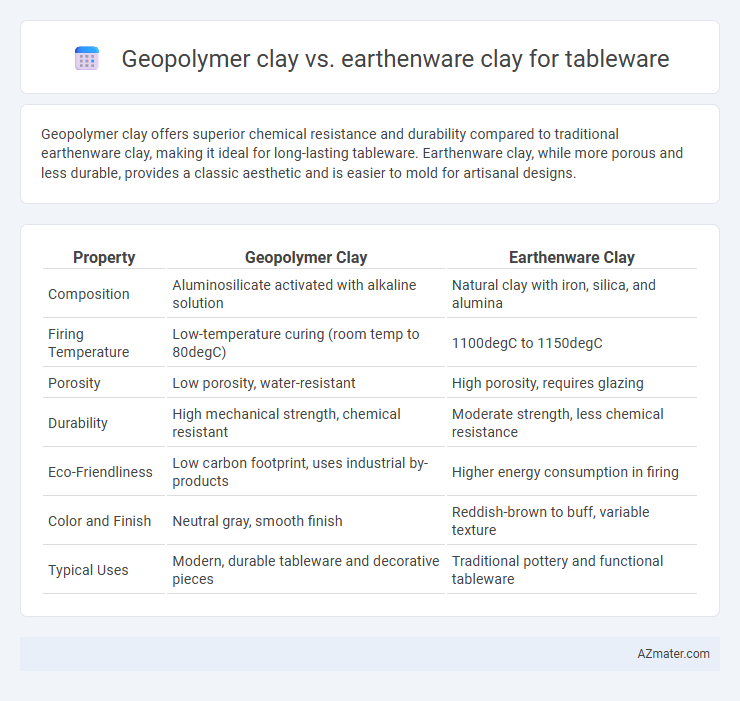Geopolymer clay offers superior chemical resistance and durability compared to traditional earthenware clay, making it ideal for long-lasting tableware. Earthenware clay, while more porous and less durable, provides a classic aesthetic and is easier to mold for artisanal designs.
Table of Comparison
| Property | Geopolymer Clay | Earthenware Clay |
|---|---|---|
| Composition | Aluminosilicate activated with alkaline solution | Natural clay with iron, silica, and alumina |
| Firing Temperature | Low-temperature curing (room temp to 80degC) | 1100degC to 1150degC |
| Porosity | Low porosity, water-resistant | High porosity, requires glazing |
| Durability | High mechanical strength, chemical resistant | Moderate strength, less chemical resistance |
| Eco-Friendliness | Low carbon footprint, uses industrial by-products | Higher energy consumption in firing |
| Color and Finish | Neutral gray, smooth finish | Reddish-brown to buff, variable texture |
| Typical Uses | Modern, durable tableware and decorative pieces | Traditional pottery and functional tableware |
Introduction to Geopolymer and Earthenware Clays
Geopolymer clay is an innovative material composed of aluminosilicate minerals activated by alkaline solutions, offering enhanced durability and chemical resistance compared to traditional clays. Earthenware clay, a porous, low-fired natural clay with high iron content, has been widely used for centuries in pottery, characterized by its warm, reddish tones and relatively lower strength. For tableware production, geopolymer clays provide superior mechanical properties and environmental benefits, while earthenware clays maintain cultural significance and aesthetic appeal through their classical texture and color variations.
Composition and Material Properties
Geopolymer clay for tableware consists primarily of aluminosilicate materials activated by alkaline solutions, offering superior chemical resistance, high thermal stability, and enhanced durability compared to traditional earthenware clay composed of natural clays with silica and alumina. The inorganic polymer network in geopolymer clay results in a denser, less porous structure, improving mechanical strength and reducing water absorption relative to the more porous and less chemically resistant earthenware. These material properties make geopolymer clay a promising alternative for functional tableware requiring greater longevity and resistance to thermal shock.
Environmental Impact and Sustainability
Geopolymer clay offers a significantly lower carbon footprint compared to traditional earthenware clay due to its reliance on industrial byproducts like fly ash and slag, reducing the need for high-temperature kiln firing and raw material extraction. Earthenware clay, while biodegradable and natural, often requires prolonged firing at temperatures exceeding 1000degC, resulting in higher energy consumption and CO2 emissions. Utilizing geopolymer clay enhances sustainability in tableware production by minimizing resource depletion and decreasing environmental pollution.
Strength and Durability Comparison
Geopolymer clay offers superior strength and durability compared to traditional earthenware clay, making it ideal for robust tableware that resists chipping and cracking. Its chemical composition allows it to withstand higher thermal and mechanical stress, enhancing longevity in everyday use. Earthenware clay, while more porous and less dense, remains vulnerable to breakage and wear, requiring careful handling and glazing for improved durability.
Workability and Handling Differences
Geopolymer clay offers superior workability with a consistent plasticity and faster setting time, enabling precise molding and less deformation during shaping, unlike earthenware clay which requires longer drying times and careful moisture control to avoid cracking. Handling geopolymer clay reduces the risk of air bubbles and shrinkage due to its chemical curing process, while earthenware clay's natural composition demands skilled manipulation to prevent warping and uneven drying. Tableware crafted from geopolymer clay benefits from increased durability and reduced firing times, whereas earthenware relies on traditional kiln firing and is more susceptible to breakage.
Firing Temperature and Process
Geopolymer clay requires a low-temperature curing process, typically around 60-90degC, avoiding traditional high-temperature kiln firing used in earthenware clay, which must be fired between 1000-1150degC. This difference in firing temperature highlights geopolymer clay's energy efficiency and rapid hardening via chemical polymerization rather than the vitrification process in earthenware. Choosing geopolymer clay for tableware production reduces thermal stress and enables faster manufacturing cycles compared to the prolonged high-temperature firing necessary for earthenware ceramics.
Aesthetic Qualities and Color Range
Geopolymer clay offers a contemporary, smooth finish with a limited but modern color palette, often ranging from neutral grays to subtle earth tones, ideal for minimalist tableware designs. Earthenware clay provides rich, warm hues such as terracotta, reds, and browns, delivering a rustic and traditional aesthetic favored in artisanal and classic table settings. Both materials enable unique textures and finishes, but earthenware's broad color spectrum offers more versatility in creating vibrant, visually dynamic tableware.
Safety and Food Compatibility
Geopolymer clay offers superior chemical resistance and lacks toxic heavy metals, making it highly safe for food contact compared to traditional earthenware clay, which may contain lead or other harmful contaminants if not properly glazed. Earthenware requires a vitrified, food-safe glaze to prevent porosity and eliminate risks of bacterial growth or leaching, while geopolymer's dense, non-porous structure inherently reduces these hazards. Regulatory compliance for tableware favors geopolymer clay due to its stable molecular composition, ensuring prolonged food safety without degradation over time.
Cost and Availability
Geopolymer clay offers a cost-effective alternative to traditional earthenware clay due to lower raw material expenses and reduced energy consumption during curing. Earthenware clay remains widely available and accessible from numerous suppliers, ensuring consistent supply for large-scale production. Geopolymer clay's emerging market may limit immediate availability, but its growing adoption is improving access and reducing costs over time.
Choosing the Right Clay for Tableware
Geopolymer clay offers superior durability, chemical resistance, and low water absorption, making it ideal for long-lasting, dishwasher-safe tableware. Earthenware clay, while more porous and less durable, provides a traditional aesthetic with vibrant glazing options, suited for decorative or casual use. Selecting the right clay depends on desired functional properties and style preferences, balancing the strength and maintenance of geopolymer clay against the artistic appeal and historic charm of earthenware.

Infographic: Geopolymer clay vs Earthenware clay for Tableware
 azmater.com
azmater.com